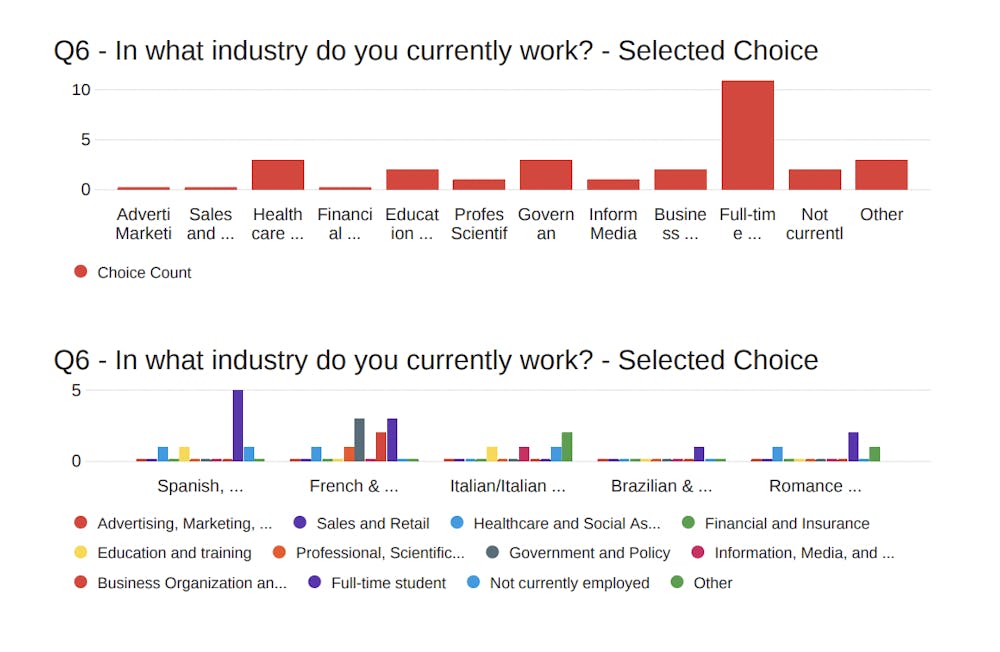Have you ever wondered how many people decide to get a second or even third degree after Duke?
The Chronicle sought to report a breakdown of which graduate and professional schools Duke undergraduates end up attending, but soon learned that information is hard to find.
Some alumni plans are widely known because they received a competitive scholarship. For example, Duke’s 52 Rhodes Scholars indicate that at least that many people attended the University of Oxford. Likewise, 17 Gates-Cambridge Scholars and 20 Churchill Scholars have gone to the University of Cambridge, and at least four Knight-Hennessy Scholars have gone to Stanford University.
However, multiple academic departments contacted by The Chronicle couldn’t give specifics on what schools their graduates ended up attending.
Dean Bruno, graduate business school advisor and academic dean for Robertson Scholars, wrote in an email that he’s not aware of any campus offices tracking what graduate and professional schools alumni matriculate to.
Two departments identified Alumni Affairs as a potential source of information. The association does not track post graduate data related to graduate study, according to Tracey Temne, associate vice president of marketing, communications, and stewardship of Duke's Alumni Engagement and Development.
What departments know
Susan Rodger, director of undergraduate studies for the department of computer science, wrote that it’s hard to track students’ postgraduate plans.
“Some [computer science majors] go to graduate school, but many get a job in industry,” Rodger wrote.
The timeframe in which students apply to schools can also impact data collection.
“One of the challenges with graduate business school admission information is that traditional MBA programs have a requirement that applicants must work for 4-5 years before applying,” Bruno wrote. “We seldom hear from an alum when they apply years down the road.”
Every academic department has a selection of alumni profiles on their websites, which can give a glimpse into what some students do after graduation.
For example, African and African American studies graduates matriculated to schools of business, medicine and law, as well as traditional research programs. Meanwhile, art, art history and visual studies sent students to art schools and other graduate and professional schools.
Some areas of the University conduct more robust surveys.
The Pratt School of Engineering highlights results from its Class of 2020 exit survey on its website. Overall, about a quarter of respondents said they planned to go to graduate or professional school.
Schools attended by biomedical engineering graduates include Oxford, Harvard Medical School, Baylor College of Medicine, Columbia University and Stanford Law School.
Schools attended by civil and environmental engineering graduates include the University of Texas at Austin, Stanford University, the University of Illinois Urbana-Champaign, the University of Southern California and the University of California Berkeley.
The romance studies department provided The Chronicle results of a 2021 alumni survey showing what career path Spanish, French, Italian, Portuguese and romance studies majors took after graduation.
About a quarter of the 41 respondents were full-time students at the time of the survey, although the survey does not specify at which institutions. The department was unable to say which class years were represented in the survey.

The chemistry department provided data on postgraduate plans going back to the Class of 2008, although there are some years missing in the data.
“We’re piecing together what we have found and cumulatively hope this represents a trend in chemistry placement data,” wrote Meg Avery, assistant to the director of undergraduate studies for chemistry.
The data shows that medical school, graduate school and full-time jobs are the most common outcomes for chemistry majors.
The biology department combined information from its annual senior exit survey, public records and pre-health matriculation data to understand where the Classes of 2017, 2018 and 2019 ended up after graduation.
About 84% of those alumni are represented in the data, said Ron Grunwald, director of undergraduate studies for biology. The data includes what students did immediately after graduation as well as what they did years later.
Nearly 60% of respondents matriculated to M.D. or M.D.-Ph.D. programs, with another 9% saying they intended to go to medical school. Another 9% went to graduate school.
Top choices for medical schools
The School of Medicine was the most popular choice for Duke graduates over the last three years, according to a list provided by Alyssa Perz, director of the health professions advising office.
The list included medical schools where 10 or more students matriculated from 2019 to 2021. The second and third most popular schools were the University of North Carolina at Chapel Hill and Harvard Medical School, respectively.
Other schools with 10 or more attendees over the last three years were:
- Icahn School of Medicine at Mount Sinai
- Johns Hopkins University School of Medicine
- Case Western Reserve University School of Medicine
- Perelman School of Medicine at the University of Pennsylvania
- University of Virginia School of Medicine
- Wake Forest School of Medicine of Wake Forest Baptist Medical Center
- Washington University in St. Louis School of Medicine
- Mayo Clinic Alix School of Medicine
- Weill Cornell Medicine
- Tufts University School of Medicine
- University of Florida College of Medicine
- Columbia University Vagelos College of Physicians and Surgeons
- New York University Grossman School of Medicine
- USF Health Morsani College of Medicine
The exact number of students that continued on to each school wasn’t specified, but Duke’s popularity is also reflected in student-generated data.
The Duke Medical Mentorship Advisory Program created a database of M.D. students available to mentor medical school applicants. The database shows that out of 219 people who attended Duke for undergrad between 2007 and 2020, one in five continued their studies at the School of Medicine.
Data visualizations by Nadia Bey.
Editor's Note: This story was updated Friday afternoon to include comment from Alumni Engagement & Development that the association does not collect post graduate data related to graduate studies.
Get The Chronicle straight to your inbox
Signup for our weekly newsletter. Cancel at any time.

Nadia Bey, Trinity '23, was managing editor for The Chronicle's 117th volume and digital strategy director for Volume 118.

